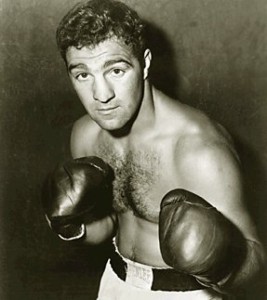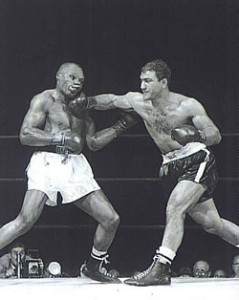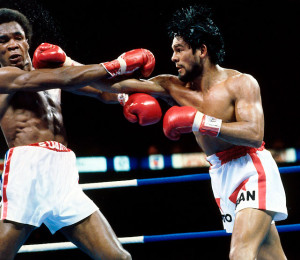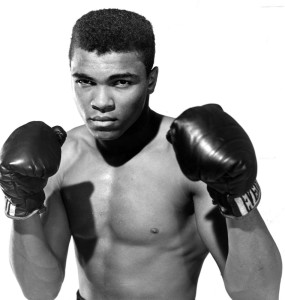10. Sugar Ray Leonard (40-3-1)
“Boxing is the ultimate challenge. There’s nothing that can compare to testing yourself the way you do every time you step in the ring.”

Sugar Ray Leonard (Wilmington, NC, May 17, 1956) is an American former professional boxer first in the history of professional boxing with world titles in five categories, and considered one of the most popular and successful boxers of all times.
Career
His amateur career was completely solid and unique winning many championships, including a gold medal in the 1976 Summer Olympics, and obtaining a record of 145-5, 75 by KO.
He achieves his definitive consolidation after beating the then WBC welterweight champion, Wilfred Benitez.
In June 1980, he decided to measure forces with Roberto “Hands of Stone” Duran, starring the so-called “Fight of the Century”. But the surprise came in Panama, one of the most exciting battles memorable wins in all fairness. The euphoria was just another fight, the rematch was held in November of that same year, where Leonard regain the World Title, after Duran refused to continue the fight wore on the eighth round in a fight where Sugar asked for a ring special size 21 x 21.
In 1981, again one of the most exciting bouts in the history of boxing, against Thomas Hearns, to unify the WBC and WBA welterweight titles. In the 14th round, and after harsh combinations, the referee is forced to stop the bout before the manifest superiority of Sugar Ray. After that triumph he was considered the best Welterweight fighter in history.
“ Best Welterweight fighter in history ”
The 80s superfight
In February 1982, doctors discovered that Leonard has a detached retina, which meant he could not keep fighting. Hence his first withdrawal boxing appears. He returned on May 11, 1984, knocking out Kevin Howard in nine rounds and disappeared again in the ring until three years later shocking the boxing world once again when it was announced he would fight middleweight champion Marvin “Marvelous” Hagler.
The fight generated enormous interest, and was billed as the “‘80s superfight.” Against all odds, and in a spectacular fight, Leonard was declared new middleweight champion of the world, by split decision, which marked his third crown in different categories.
After another retirement announcement, back in November 1988, fighting with Don Lalonde, but is hurt in the fourth round by a cut on his nose. However he gets up and knocks him out in the ninth round, winning two titles in one fight, Middleweight and Light.
Last appearance
In 1989, two separate classic reissued before Thomas Hearns and Roberto Duran, Hearns tying and beating Duran at points. But nevertheless on 9 February next year a young Terry Norris in one of his best, winning by unanimous decision to Leonard giving him a beating and, according to some, pardoning a KO, after which he again announced his retirement.
 In 1997, at age 40, he made his last appearance, being defeated by the then former world lightweight champion Hector Camacho. That same year, Leonard was inducted into the Boxing Hall of Fame.
In 1997, at age 40, he made his last appearance, being defeated by the then former world lightweight champion Hector Camacho. That same year, Leonard was inducted into the Boxing Hall of Fame.
Early life
The name of Ray came by the admiration of his mother Getha by singer Ray Charles. Leonard is truly interested in boxing at age 14, after trying in wrestling, ballet, ice skating and gymnastics. Ray began to frequent the Center of Palmer Recreation Park where he was helper by former boxer Dave Jacobs.
The interest of Ray grew as it knew this sport and to silence critics of his family who branded him a “sissy”. Leonard trained with much stronger and bigger boxers than him, which led him to receive many beatings, but its quality and increased weight made him the master of the gym. After participating in several regional tournaments it was included in the national team, while being underage.
After failing in his attempt to participate in the 1972 Summer Olympics he came to the appointment in Montreal 1976 and won the gold medal in the end against Cuban Andres Aldama. Leonard fought during the Olympic Games with photos of his son Ray Jr. and his mother, Juanita, in the socks. This, his nature and his good looks made him be the more popular Olympic winner in the United States.
9. Rocky Marciano (49-0-0)
“Why waltz with a guy for 10 rounds if you can knock him out in one?”

Rocky Marciano (Massachusetts, USA, September 1, 1923 Iowa, USA, August 31, 1969) is the pugilistic (1946-1956) adopted by Rocco Francis Marchegiano, born in Brockton, Massachusetts.
It was an Italian-born American boxer who retired undefeated, the only boxing champion heavyweight who knew no defeat. Also he remained an unbeaten boxer in his time in the army (1944-1946). Marciano has an impressive record of 43 knockouts, equivalent to 87.76% of his fights, despite his somewhat unorthodox boxing style as “Squat”.
Rocco was world champion in the category of heavyweight boxing in the period since the September 23, 1952 (when he won the title against Jersey Joe Walcott) to November 30, 1956 the day when, with almost 33 years, announced his retirement after defending his title six times. His height was 180.3 cm (5 feet 11 inches), and weighs 82-88 kg (176-193 lb). The International Boxing Research Organization (IBRO) has ranked among the top 10 heavyweights history.
Turning pro
He began boxing in the United States Army in 1944 and fought once under the name Rocky Mack to preserve his amateur status. In the beginning, boxing does not seem to be his sport, and leaves him to try his luck in baseball. Interestingly, he lacked strength to throw the ball.
 He turned pro on March 17, 1947 and 1951 cried after he knock out the hero of his youth, the former world champion Joe Louis. On September 23, 1952 Marciano knocked Jersey Joe Walcott becoming the heavyweight championship in one of his most memorable fights. At the time of the KO occur in the thirteenth round, Marciano was losing on the cards of judges.
He turned pro on March 17, 1947 and 1951 cried after he knock out the hero of his youth, the former world champion Joe Louis. On September 23, 1952 Marciano knocked Jersey Joe Walcott becoming the heavyweight championship in one of his most memorable fights. At the time of the KO occur in the thirteenth round, Marciano was losing on the cards of judges.
Undefeated retiring
From the year 1953 to 1955 he managed to successfully defended the title six times. Upon retiring in April 1956, he achieved 49 wins, 43 of them before the end, and no defeats. It went down in history as the only world champion heavyweight retiring undefeated. The greatest virtue of Rocky Marciano was his power punching, but his ability to lace was no less outstanding, as curiosity is the fact that in many fights, always victorious, he had his face more damaged then the defeated one.
If Walcott was greater than Marciano, Ezzard Charles too, and though not a natural heavy had victories over major rivals even beat the same Joe Louis, but could not with the great Marciano and hurried to seek revenge by saying that he would ” bypass” the champion, and Rocco once again tried to “explain “why he reigns, Charles certainly understood. He died on August 31, 1969, one day before his 46 years in a plane crash near Newton, Iowa.
8. Roberto Duran (103-16-0)
“Nobody stands out right now. Everybody has similar styles. None of these fighters have reinvented the wheel and created a new style.”

Roberto Carlos Duran Samaniego is a retired professional boxer from Panama (nicknamed “Mano de Piedra” or “El Cholo”) born on June 16, 1951. Duran is recognized worldwide as the best lightweight (135 pounds) of all time, and also widely catalogued by sportswriters and international boxing historians to be the greatest Latin American boxer and one of the best pound for pound in the history of boxing, defeating lightweight champions and other contemporaries such as Esteban de Jesus, Suzuki -Guts – Ishimatzu and was able to bring the Latino boxing at the highest levels, facing many of the best fighters of all ages in different boxing categories, performing like a combat veteran.
American Rich O’Brien, catalogues Duran in No. 3 among “Ten Greatest Boxers Pound for Pound”, also was granted by Sports Illustrated, the number one among “the ten largest lightweights All Time”, ESPN ranked him in ranked No. 6 in the list of “The 50 Greatest Boxers of History” while for The Ring magazine is number 5 on the list of “The 80 Best Boxers Historical Between 1922-2002”. In 2003, the same publication awarded the 28th place in its list of “The 100 Best Rappers in boxing history.”
Career
The head coach of Roberto Duran was Nestor Quiñónez, the popular “Lead Espinosa.” According to the golden records, the only two losses of Roberto Duran in his career as an amateur boxer were to countryman Jorge Maynard which popularly known as El Mello. Roberto Duran was paid $ 25 in his first pro fight in the bantamweight (118 pounds), when he won a decision in four rounds at future World title contender, the chiricano Carlos Mendoza, in the arena of Columbus in the professional debut of both, on February 23, 1968; the main event staged on the Colombian and Panamanian Heliodoro Pitalúa Miguel Riasco.
“ He had some big punches ”
The lawsuit co-feature was a clash between Panamanian Ernesto “Nato” Marcel and Incarnation “Machito” Guerrero. After a brief amateur career, Duran professionalism starting debut in the bantamweight, super bantamweight -the division (122 pounds) was not officially established until much later, in 1972, when he was active, Duran subsequently ascended the featherweight (126 pounds) and super featherweight (130 pounds) accumulating a balance 21-0-18 (KO) before invading and settling in the lightweight (135 pounds) to fight for the first time in the boxing division on March 21, 1971 against Venezuelan Jose Acosta, (17-14-6-9KO) whom he defeated by KO in the first fight.
Favourite moves
He had some big punches, with its long straight right over the left shoulder of the rival, his favourite move and he was hitting the sides of the rivals and trapping against the ropes while severe combinations connected to low levels; I dominated the three distances, but their land was short, with constant moorings and the median distance was beating in his strongest point.
 Duran’s career was guided from its first to its last fight for “Lead” Espinoza, but since his fight against Hiroshi Kobayashi (09.04.61) in 1971 to the second fight with Sugar Ray Leonard in 1980, his manager Carlos Eleta hired first class coaches like Ray Arcel and Freddie Brown, who came to produce 15 and 8 world champions such as Larry Holmes and Rocky Marciano, respectively and polished style of Duran on the defensive in the case of Arcel, while Brown designed Duran strategies to attack the body and low levels of rivals. For the 90 alternated in his corner coaches Rigoberto Garibaldi and Czech Bernardo, to return Espinoza in his last fight to steer the corner.
Duran’s career was guided from its first to its last fight for “Lead” Espinoza, but since his fight against Hiroshi Kobayashi (09.04.61) in 1971 to the second fight with Sugar Ray Leonard in 1980, his manager Carlos Eleta hired first class coaches like Ray Arcel and Freddie Brown, who came to produce 15 and 8 world champions such as Larry Holmes and Rocky Marciano, respectively and polished style of Duran on the defensive in the case of Arcel, while Brown designed Duran strategies to attack the body and low levels of rivals. For the 90 alternated in his corner coaches Rigoberto Garibaldi and Czech Bernardo, to return Espinoza in his last fight to steer the corner.
Another feature he possessed was his excellent defence, because to be a boxer puncher style, had good movement on the parquet, and rather than being a static type that depended only on a strong jaw, had head and torso movements that used to evade rivals. It also stresses that he was not a stylist but a puncher, he had great reflexes and hand speed in the light and welterweight categories.
Some good fights
Upon a victory over former world champion, Hiroshi Kobayashi, (4.9.61) and against veteran Angel Robinson Garcia (121-56-20) in 1971, June 26, 1972, in New York, world lightweight champion was proclaimed (135 pounds) then defeating by TKO in the world champion of the World Boxing Association, the Scottish stylist Ken Buchanan (43-1-0). He made 12 defences of this title (plus 33 fights with no title at stake in that category that was common at the time) 11 won by knockout and unifying it in his last defence against the champion of the World Boxing Council, Esteban Jesus, (52-3-0) who was the first that was able to defeat and sent Duran to the canvas in a previous case where there was no title at stake.
Besides Esteban de Jesus, he fought champions like Ishimatsu Suzuki, Hector Thompson, Lou Bizarro, Jimmy Robertson, Saoul Mamby, Vilomar Fernandez among others; Edwin Viruet only came to the end in a game title bout at lightweight, he made some good fights, but the Panamanian demonstrated a mastery of his opponents in that division. In 1999, The Associated Press Roberto Duran ranked number 7 in the list of “the best boxers of the twentieth century” and give the 1st place in “The Greatest Light Heavyweight” in that position surpassing other legends of that division enshrined as Benny Leonard, Ike Williams, Joe Gans and Carlos Ortiz.
7. Muhammad Ali (56-5-0)
“He who is not courageous enough to take risks will accomplish nothing in life.”- Muhammad Ali
 Muhammad Ali (born Cassius Marcellus Clay Jr. on January 17, 1942, in Louisville, Kentucky, USA) is a former professional boxer and a world champion in boxing. In 1974 he was elected sportsman of the year in the US, and in 1999, Ali was named “Athlete of the Century” by US magazine Sports Illustrated. He is considered the greatest heavyweight boxing champion and one of the most popular athletes of all time. Since the beginning of his professional career he was saying that he is The Greatest and as a miracle, it kind of became true.
Muhammad Ali (born Cassius Marcellus Clay Jr. on January 17, 1942, in Louisville, Kentucky, USA) is a former professional boxer and a world champion in boxing. In 1974 he was elected sportsman of the year in the US, and in 1999, Ali was named “Athlete of the Century” by US magazine Sports Illustrated. He is considered the greatest heavyweight boxing champion and one of the most popular athletes of all time. Since the beginning of his professional career he was saying that he is The Greatest and as a miracle, it kind of became true.
He was named after his father, Cassius Marcellus Clay, Sr. and changed his name in 1964, when converted to Islam (Sunni Islam). He began training at the age of 12, succeeding at the age of 22 in 1964 to win the first world heavyweight title in a match with Sonny Liston. He also won titles in 1974 and 1978.
Refusing army
In 1967, three years after winning the title, Ali refused enlistment into the US Army on religious grounds, and opposing US involvement in the Vietnam War. The US government refused to consider conscientious objection because Ali said it would fight a war if so i would ask Allah and his messenger (Elijah Muhammad). He was initially arrested and found guilty of evading military service, losing in the same day his boxing license.
Therefore he did not fight for almost four years, from 23 to 27, losing the maximum performance of his career. His appeal reached to the Supreme Court of the United States, where in 1971 it was decided and the conviction was overturned because the Board of Appeal did not give reasons for not accepting the refusal of conscientious objection. This made Ali one of representatives of the counterculture generation.
Public reputation
In a time when most fighters left their managers to speak in public, Ali was inspired by wrestler “Gorgeous” George Wagner, he captured the whole attention, sometimes being provoked and often ironic and fun. He said about Frazier that he was “too stupid to be champion,” about Terrell that he was an “Uncle Tom” about Patterson that he was a “rabbit” and the Liston he would whip him “like his father used to do.”
It was the main voice of press conferences and interviews where he spoke freely about issues unrelated to boxing. Ali took over the role and image of the African-American athlete in America who takes pride in his race and antagonized the white majority. According to a famous sports writer, he was a boxer, one of few who “defined the term public reputation“.
Movies were made about his life and career and he himself was cast as an actor in several films, being portrayed, among others, by Will Smith in 2001, for which he was nominated for an Oscar. A recent documentary from 2013 “Muhammad Ali processes”, plays the turbulent years that followed Ali’s refusal to enlist in the US Army, which is in the war with Vietnam.
